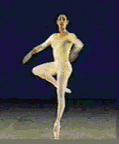Aplomb
In classical ballet, aplomb (French pronunciation: [aplɔ̃]) refers to an unwavering stability maintained during a vertical pose or movement. The word is of French origin, coming from à plomb, "according to the plummet".[1]

French ballet master Jean-Étienne Despréaux used the term in 1806 to refer to the dynamic balancing that is fundamental to all well-executed ballet positions and movements.[2] In 1887, German dance theorist Friedrich Albert Zorn analogized aplomb in dancers as "the sureness of touch of the pianist".[3] Friedrich Zorn described aplomb in terms of both its outward appearance and its underlying technique, saying that "[a]plomb is the absolute safety in rising and falling back which results from the perpendicular attitude of the upper body and the artistic placing of the feet. By means of aplomb the dancer acquires a precision and an elegance which ensure the successful execution of every foot-movement, however artistic and difficult, and thereby creates a pleasing and a satisfactory impression upon the observer."[3] According to Agrippina Vaganova, aplomb relies on balance and on feeling and controlling the muscular sensations within the spine.[4]
References
| Look up aplomb in Wiktionary, the free dictionary. |
- 'aplomb. (n.d.)' Dictionary.com Unabridged, (Retrieved August 23, 2015)
- Bernard Taper (1996) "Balanchine: A Biography", ISBN 0-520-20639-8
- Grammar of the Art of Dancing, Theoretical and Practical, a translation of an 1887 book by Friedrich Zorn
- Agrippina Vaganova (1969) "Basic Principles of Classical Ballet: Russian Ballet Technique" ISBN 0-486-22036-2